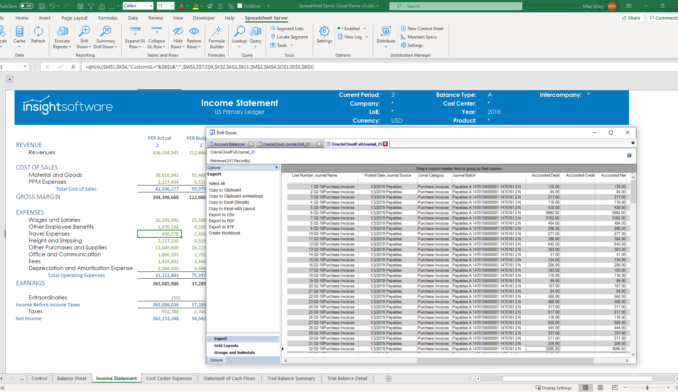How to Save Time and Money on Financial Reporting

Chances are that at some point in your career, you have seen at least one big project end in failure. Generally, the bigger and more ambitious a project is, the higher the likelihood that it will go over budget, fall short of expectations, or will be abandoned. Custom software projects often end up going down this road. So why do so many leaders choose to embark on such ventures?
What makes this worse is that in many cases, a reliable, proven, low-cost alternative exists. In other words, what you want is already available off the shelf, and the total cost of ownership is dramatically lower with these tools than with customized solutions.
When it comes to financial and operational reporting, success or failure will often depend on the overall approach you take for business intelligence. Most organizations choose one of these three options:
- They use the built-in reporting tools that come with their software.
- They invest in a heavy-duty business intelligence infrastructure and hire a team of technical experts to oversee it.
- They focus on simplicity and flexibility, along with an emphasis on 360° visibility of company operations and finances.
Built-in ERP Reporting Tools
Built-in ERP reporting tools have two primary virtues. First, they are perceived as being free (although in reality, “free” can end up being surprisingly expensive). Second, they come pre-packaged with a set of canned reports that will address many of the most common business reporting requirements.
Unfortunately, virtually every business has a need for customized reports that don’t come with their ERP system out of the box. Although every business has some common needs (such as a GL trial balance or an aged payables report), almost every organization also has unique requirements driven by the distinct business processes on which they rely every day.
As a result, every organization ends up customizing its reports to some extent.
Unfortunately, the built-in reporting tools that come with most ERP software packages are woefully lacking in user-friendliness. They typically require specialized expertise whenever a report needs to be modified or built from scratch.
Specialized expertise costs money. For businesses that have their own in-house IT staff, that means providing those experts with training, then consuming their valuable time whenever a report modification is needed. If you need something fast, or if you don’t have internal IT resources to do the job, then you’ll end up paying outside consultants to do it for you. Again, it’s an expensive proposition.
There is considerable risk involved with any custom project, including report customization. If requirements are poorly defined, or if communication between developers and end-users is inadequate, it often results in a product (in this case, a customized report) that does not sufficiently address the needs of the person who requested it. Another iteration might fix the problem, but again, that costs money and time. The riskiest issue here is the lag time between the need of the report by senior management and the actual time it takes to produce the report; anything could happen when the management team is flying half blind.
Finally, there is the problem of the limited scope of these tools. Built-in reporting tools are designed to report on data in the ERP system, without taking into account the fact that most companies are running separate systems for CRM, warehousing, or shipping. Getting data into any of those systems may be easy, but getting actionable information out is exceedingly difficult. When every system is treated as a silo unto itself, it’s virtually impossible for business leaders to get a clear view of what’s happening throughout the entire organization.
The Heavy-Duty Approach
Large, cash-rich enterprises often go for the “big iron” approach: Buy something really robust (that is, extraordinarily complicated) and hire a busload of expensive, highly-trained specialists to oversee it. For companies that can afford it, this strategy may have a proper role in informing management decisions, but it’s a bit like buying a Formula One race car to go to the mall. You’ll get there fast, but you may need to bring along a team of engineers to make sure everything continues to work properly.
Unfortunately, sometimes ERP vendors push this approach on their customers. Microsoft’s current strategy for ERP reporting, for example, is to migrate customers to its Power BI platform. As a relatively new product, Power BI has a pretty steep learning curve. To take full advantage of the platform, you’ll need a developer who is familiar with the DAX (Data Analysis Expressions) programming language.
DAX is not a common skill set, although in another ten years it might be. (Conversely, DAX might never gain traction at all and could fall out of use, leaving you to search even harder and pay more for programmers who can maintain your legacy reports.)
Ultimately the “power” in Power BI doesn’t end up where it needs to be, that is, in the hands of the finance and operations leaders who rely on timely and accurate reports to inform their decisions. When there is a delay of days or weeks between a request for information and the time it becomes available, decision-makers are flying blind.
The Third Way: Simplicity, Flexibility, and 360° Visibility
The third option is to deploy reporting tools that are designed for both robustness and ease of use.
When end-users can develop and modify reports themselves, they have immediate access to the information they need, without resorting to IT specialists or expensive outside consultants. With insightsoftware reporting products, virtually anyone who has a basic working knowledge of your ERP system can create or modify a report, without outside help.
With insightsoftware, everything can be done within the familiar, highly flexible environment of Microsoft Excel, without any copying or pasting of data from exported reports or external spreadsheets. By creating live links to ERP, CRM, or other business applications within Excel, insightsoftware’s tools enable end-users to view and manipulate data in real time. Eliminating the all-too-common process of copying and pasting information dramatically reduces the likelihood of reporting errors.
These tools are not specific to any vendor, so even if you’re running multiple ERPs (in different divisions of the company, for example), or if you have a separate CRM system or specialized business applications in addition to ERP, you can access them all. This way, you’ll benefit from a 360° view of your business.
The Costs and Risks of Bad Reporting
When you don’t have the right reporting solution in place, there is more on the line than just higher costs. If you can’t trust your reports, or if there is an unacceptable delay in getting the information you need, it can cause significant problems for your business.
Unfortunately, many organizations end up with a hodgepodge of reports from multiple systems. As a result, they often lack a single version of the truth. When the numbers on a report turn out to have been incorrect, or when there are conflicting versions of the same report, people lose faith in the numbers. Meeting time is consumed by debates about which number is correct, instead of focusing on solutions that will improve business outcomes. Having a single version of the truth should be a non-negotiable requirement for business managers everywhere.
Accuracy is not just important for internal users, though. When cash is tight and you need to tap into your line of credit, it’s important that you are able to provide accurate and up-to-date information to your bank. If you don’t, you risk losing some or all of your borrowing power. At a time when many businesses are struggling to preserve cash, that loss of power could make a big difference to your company.
Timeliness of information is also critical. When important information is delayed due to limited IT resources, business leaders are flying blind. Consider the lessons of 2020, when organizations around the world were faced with unprecedented change. As leaders struggled to pivot, agility moved to center stage as one of the key attributes necessary for survival and long-term competitive advantage. When information is slow to materialize, or when reports reflect outdated information, agility is virtually impossible to achieve.
When stimulus funds were made available to businesses in the United States, for example, those who acted quickly were able to receive loans before anyone else. Those that lagged behind were left to wait for round two. More than ever before, businesses must move fast. At insightsoftware, we enable decisions to happen as fast as your business needs to make them.
The powerful and flexible reporting tools available from insightsoftware provide simplicity and flexibility in financial and operational reporting for organizations running a wide range of ERP, CRM, and other business software systems. Reports can be designed, modified, and securely distributed throughout the organization. To learn more about how insightsoftware can help you lower your costs and increase agility, contact us for a free demo .










